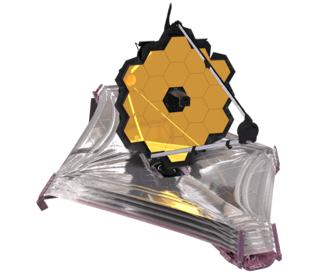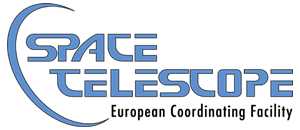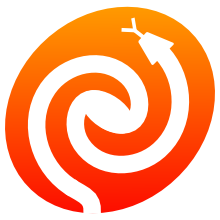
The Hubble Space Telescope is a space telescope that was launched into low Earth orbit in 1990 and remains in operation. It was not the first space telescope, but it is one of the largest and most versatile, renowned as a vital research tool and as a public relations boon for astronomy. The Hubble telescope is named after astronomer Edwin Hubble and is one of NASA's Great Observatories. The Space Telescope Science Institute (STScI) selects Hubble's targets and processes the resulting data, while the Goddard Space Flight Center (GSFC) controls the spacecraft.

KStars is a free and open-source planetarium program built using the KDE Frameworks. It is available for Linux, BSD, macOS, and Microsoft Windows. A light version of KStars is available for Android devices. It provides an accurate graphical representation of the night sky, from any location on Earth, at any date and time. The display includes up to 100 million stars, 13,000 deep sky objects, constellations from different cultures, all 8 planets, the Sun and Moon, and thousands of comets, asteroids, satellites, and supernovae. It has features to appeal to users of all levels, from informative hypertext articles about astronomy, to robust control of telescopes and CCD cameras, and logging of observations of specific objects.

The Space Telescope Science Institute (STScI) is the science operations center for the Hubble Space Telescope (HST), science operations and mission operations center for the James Webb Space Telescope (JWST), and science operations center for the Nancy Grace Roman Space Telescope. STScI was established in 1981 as a community-based science center that is operated for NASA by the Association of Universities for Research in Astronomy (AURA). STScI's offices are located on the Johns Hopkins University Homewood Campus and in the Rotunda building in Baltimore, Maryland.

The James Webb Space Telescope (JWST) is a space telescope designed to conduct infrared astronomy. Its high-resolution and high-sensitivity instruments allow it to view objects too old, distant, or faint for the Hubble Space Telescope. This enables investigations across many fields of astronomy and cosmology, such as observation of the first stars and the formation of the first galaxies, and detailed atmospheric characterization of potentially habitable exoplanets.

IRAF is a collection of software written at the National Optical Astronomy Observatory (NOAO) geared towards the reduction of astronomical images and spectra in pixel array form. This is primarily data taken from imaging array detectors such as CCDs. It is available for all major operating systems for mainframes and desktop computers. IRAF was designed cross-platform, supporting VMS and UNIX-like operating systems. Use on Microsoft Windows was made possible by Cygwin in earlier versions, and can be today done with the Windows Subsystem for Linux. Today, it is primarily used on macOS and Linux.

STS-82 was the 22nd flight of the Space Shuttle Discovery and the 82nd mission of the Space Shuttle program. It was NASA's second mission to service the Hubble Space Telescope, during which Discovery's crew repaired and upgraded the telescope's scientific instruments, increasing its research capabilities. Discovery launched from Kennedy Space Center, Florida, on February 11, 1997, returning to Earth on February 21, 1997, at Kennedy Space Center.
The Digitized Sky Survey (DSS) is a digitized version of several photographic astronomical surveys of the night sky, produced by the Space Telescope Science Institute between 1983 and 2006.

The Space Telescope – European Coordinating Facility (ST-ECF) was an institution which provided a number of support and service functions primarily for European observers of the NASA/ESA Hubble Space Telescope (HST). It was established in 1984 by the European Space Agency (ESA) and the European Southern Observatory (ESO), and was located at the ESO headquarters in Garching bei München, Germany. The ST-ECF ceased operations on 31 December 2010.

The Starlink Project, referred to by users as Starlink and by developers as simply The Project, was a UK astronomical computing project which supplied general-purpose data reduction software. Until the late 1990s, it also supplied computing hardware and system administration personnel to UK astronomical institutes. In the former respect, it was analogous to the US IRAF project.
Hubble search for transition comets was a study involving amateur astronomers and the use of the Hubble Space Telescope, one of only six studies involving amateur astronomers approved by NASA.

The aXe Spectral Extraction and visualization software is designed to process large format astronomical slitless spectroscopic images such as those obtained with the Advanced Camera for Surveys (ACS) on the Hubble Space Telescope (HST). aXe is distributed as a subpackage for IRAF. The various aXe task can be executed within PyRAF, a command language that runs IRAF tasks and is based on the Python programming language.
POA CALFOS is the improved Post Operational Archive version of the Faint Object Spectrograph (FOS) calibration pipeline, an earlier instrument aboard the Hubble Space Telescope (HST). STScI made an improved version of the FOS calibration pipeline called POA_CALFOS. POA CALFOS replaces CALFOS, which performed the routine calibration of FOS data in the standard IRAF/STSDAS FOS calibration pipeline. The current version corrects for image motion problems that have led to significant wavelength scale uncertainties in the FOS data archive. The improvements in the calibration enhance the scientific value of the data in the FOS archive, making it a more homogeneous and reliable resource.
In observational astronomy an On-The-Fly Calibration (OTFC) system calibrates data when a user's request for the data is processed so that users can obtain data that are calibrated with up-to-date calibration files, parameters, and software.
An association (astronomy) is a combined or co-added group of astronomical exposures from which cosmic rays have been removed. WFPC2 associations constitute one type of association and are tools in the Hubble Space Telescope (HST) archive for using data from the Wide Field and Planetary Camera 2 (WFPC2). Associations were introduced in the HST archive at the beginning of 1998. Since then, astronomers have been able to retrieve on-the-fly re-calibrated co-added WFPC2 images that have already been cleaned of cosmic rays from the Space Telescope European Coordinating Facility (ST-ECF), the Canadian Astronomy Data Centre (CADC) and Space Telescope Science Institute (STScI) archives.
Drizzle is a digital image processing method for the linear reconstruction of undersampled images. The method is normally used for the combination of astronomical images and was originally developed for the Hubble Deep Field observations made by the Hubble Space Telescope. The algorithm, known as variable-pixel linear reconstruction, or informally as "Drizzle", preserves photometry and resolution, can weight input images according to the statistical significance of each pixel, and removes the effects of geometric distortion on both image shape and photometry. In addition, it is possible to use drizzling to combine dithered images in the presence of cosmic rays.

Rodger Evans Doxsey was an American physicist and astronomer who made major contributions to the scientific and operational success of NASA's Hubble Space Telescope (HST). He joined the HST Project at the Space Telescope Science Institute (STScI), in Baltimore, Maryland, in 1981, and was head of the Hubble Missions Office when he died in 2009.

Charles Mattias ("Matt") Mountain is currently the President of the Association of Universities for Research in Astronomy (AURA) which designs, builds, and operates telescopes and observatories for the National Science Foundation (NSF) and the National Aeronautics and Space Administration (NASA). AURA's NASA center is the Space Telescope Science Institute (STScI), responsible for the science mission for the Hubble Space Telescope, the science and operations for the James Webb Space Telescope, and the MAST data archive. AURA's NSF centers are Gemini Observatory, the National Optical Astronomy Observatory (NOAO), and the National Solar Observatory (NSO). Dr. Mountain and AURA are also responsible for the NSF construction projects: the Daniel K. Inouye Solar Telescope (DKIST) on Haleakalā, Hawaii and the Large Synoptic Survey Telescope (LSST) on Cerro Pachón in Chile.

Astropy is a collection of software packages written in the Python programming language and designed for use in astronomy. The software is a single, free, core package for astronomical utilities due to the increasingly widespread usage of Python by astronomers, and to foster interoperability between various extant Python astronomy packages. Astropy is included in several large Python distributions; it is part of package managers for Linux and macOS, the Anaconda Python Distribution, Enthought Canopy and Ureka.
The Mikulski Archive for Space Telescopes (MAST) is an astronomical data archive. The archive brings together data from the visible, ultraviolet, and near-infrared wavelength regimes. The NASA funded project is located at the Space Telescope Science Institute (STScI) in Baltimore, Maryland and is one of the largest astronomical databases in the world.










